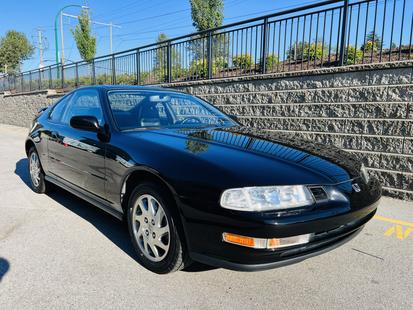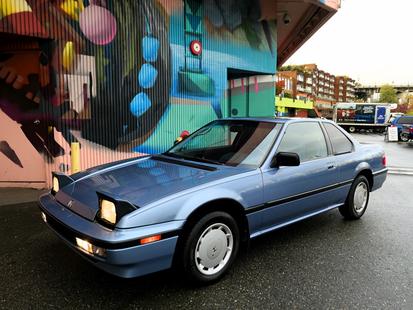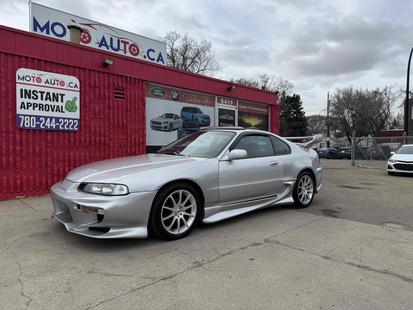The Honda Prelude is a classic blend of sporty performance and Honda reliability that has captured the hearts of driving enthusiasts for decades. Positioned as a sport compact car, the Prelude offers a refined driving experience with its sleek design and advanced technology. It stands out in the market as a vehicle that combines style, performance, and affordability, making it a favorite among those seeking a balanced and exhilarating ride.
History and Background
The Honda Prelude was first introduced in 1978 as a two-door sports coupe, designed to offer a blend of sporty performance and everyday usability. Over its five generations, the Prelude evolved significantly, integrating advancements in technology and engineering to remain competitive in the sports coupe segment.
The Prelude's history is marked by its continuous improvement in design and performance. Known for introducing features such as a sunroof as standard and advanced four-wheel steering, the Prelude set several benchmarks for innovation. The model was discontinued in 2001, but it remains a beloved classic for many enthusiasts.
Key Dates:
- 1978: First generation Prelude introduced
- 1987: Third generation introduces four-wheel steering
- 1992: Fourth generation with advanced VTEC engines
- 1997: Fifth generation with updated styling and features
- 2001: Prelude production ends

1995 Honda Prelude
$38,800
47,845 miles

1990 Honda Prelude 2dr Coupe S
$18,980
89,160 miles

1995 Honda Prelude
$18,800
63,269 miles
Performance and Handling
| Variant | Engine | Power | 0-60 | Top Speed | Fuel Economy |
|---|---|---|---|---|---|
| Base | 2.0L SOHC I4 | 104 hp | 9.8 sec | 115 mph | 21/26 mpg |
| Si | 2.1L DOHC I4 | 135 hp | 8.4 sec | 125 mph | 20/25 mpg |
| VTEC | 2.2L DOHC VTEC I4 | 190 hp | 6.9 sec | 140 mph | 19/24 mpg |
Interior and Comfort
| Feature | Base | Mid | Top |
|---|---|---|---|
| Air Conditioning | ✓ | ✓ | ✓ |
| Sunroof | - | ✓ | ✓ |
| Leather Seats | - | - | ✓ |
| Cruise Control | ✓ | ✓ | ✓ |
| Power Windows | ✓ | ✓ | ✓ |

1989 Honda Prelude
$15,995
62,076 miles
Technology and Features
Technology by Model Year:
- 1987: Introduced four-wheel steering
- 1992: VTEC technology for enhanced performance
- 1997: Updated infotainment with CD player
Infotainment System:
- Screen size: N/A, traditional button interface
- Features: CD player, AM/FM radio, cassette player
- Connectivity: Limited to auxiliary inputs
Driver Assistance Features:
- Standard: Anti-lock brakes, traction control
- Optional: None
Safety
The Honda Prelude was ahead of its time in terms of safety, offering features that were advanced for its era. It scored well in crash tests, thanks to its robust build and safety technology, providing peace of mind for drivers and passengers alike.
Safety Ratings:
- NHTSA Rating: 4 stars
- IIHS Rating: Acceptable
Safety Features:
- Standard: Anti-lock brakes, dual front airbags
- Optional: None
Value for Money
| Year | Condition | Price Range |
|---|---|---|
| 2001 | Excellent | $10,000 - $15,000 |
| 1997 | Good | $6,000 - $9,000 |
| 1992 | Fair | $3,000 - $5,000 |
Running Costs:
The running costs of the Honda Prelude are relatively low, thanks to its reputation for reliability and efficient engines. However, parts for older models may be harder to find, which could increase maintenance costs.
- Fuel Economy: 20/25/22 mpg
- Service Intervals:
- Oil Change: Every 5,000 miles
- Major Service: Every 30,000 miles
- Common Repair Costs:
- Clutch Replacement: $700 - $1,200
- Timing Belt Replacement: $500 - $800
Known Issues by Year:
- 1992: Timing belt failures
- 1997: Electrical issues
Competitor Comparison
Competitor 1:
- Market Position: The Toyota Celica is a direct competitor to the Prelude, offering similar sporty dynamics and a loyal fanbase.
- Features Comparison: The Celica offers a more modern design and updated technology but lacks the precise handling of the Prelude.
- Price Comparison: Typically priced similarly in the used market, with the Celica slightly more expensive due to its newer features.
- Running Costs: Similar running costs, though the Celica may have slightly higher repair costs due to more complex electronics.
Competitor 2:
- Market Position: The Nissan 240SX is another competitor known for its rear-wheel-drive layout and performance tuning potential.
- Features Comparison: The 240SX offers a more engaging driving experience with its RWD setup but lacks the interior refinement of the Prelude.
- Price Comparison: Often priced lower than the Prelude due to its niche enthusiast market.
- Running Costs: Generally higher due to its performance-focused parts and more frequent need for repairs.
Competitor 3:
- Market Position: The Mazda MX-6 competes in the same segment, offering a balance of style and performance.
- Features Comparison: Similar features with a focus on sleek design and comfortable interiors, but the Prelude often outperforms in reliability.
- Price Comparison: The MX-6 is priced similarly but may offer less in terms of resale value.
- Running Costs: Comparable, though the MX-6 may have higher parts costs due to less availability.
Verdict
The Honda Prelude remains a classic choice for those seeking a blend of performance, style, and reliability. Its enduring appeal lies in its driving dynamics and timeless design, making it a favorite among enthusiasts. While it may lack some modern conveniences, its value proposition and engaging driving experience make it a compelling choice in the used car market.